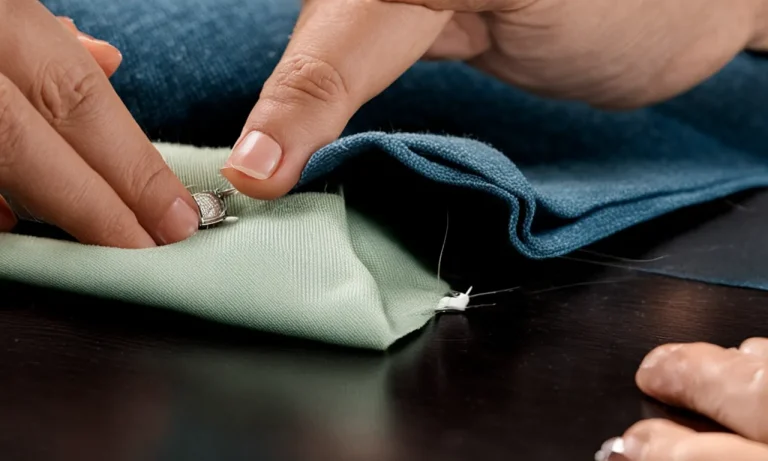How To Remove Stains From Polyester Clothing And Upholstery
We’ve all been there – that sinking feeling when you spot a new stain on your favorite polyester top or upholstered sofa. If you’re short on time, here’s a quick answer: mild dish soap, hydrogen peroxide, and vinegar can often lift fresh stains from polyester.
But read on for a comprehensive guide on removing all kinds of stains from polyester fabrics.
In this nearly 3,000 word guide, you’ll learn why stains happen on polyester fabrics, how to identify different types of stains, a step-by-step process for pretreating and removing stains, homemade stain removal solutions, tips for avoiding stains on polyester, and how to care for polyester fabrics to prevent future stains.
What Causes Stains on Polyester
Understanding the causes of stains on polyester is crucial in effectively removing them. Polyester is a synthetic fabric made from petroleum-based chemicals. While it is known for its durability and resistance to wrinkles, it is also prone to staining.
There are several factors that can contribute to stains on polyester clothing and upholstery.
The Science Behind Stains
Stains occur when foreign substances penetrate the fibers of polyester fabric. These substances can be anything from food and beverages to oil-based products and even bodily fluids. When these substances come into contact with polyester, they can bond with the fabric, resulting in unsightly stains.
One of the reasons behind the staining of polyester is its molecular structure. Polyester fibers have a smooth surface, which makes it difficult for stains to adhere to them. However, the smoothness also means that stains can easily penetrate the fibers, making them more challenging to remove.
Why Polyester is Prone to Stains
There are several reasons why polyester is particularly prone to stains:
- Oil Absorption: Polyester has a high affinity for oil-based substances, making it susceptible to oil stains. Whether it’s a greasy food spill or an accidental encounter with a greasy surface, polyester can quickly absorb and retain oil-based stains.
- Static Electricity: Polyester fabric tends to generate static electricity, which can attract and hold onto dust, dirt, and other particles. These particles can leave behind visible stains on the fabric.
- Colorfastness: While polyester is known for its ability to retain color, certain dyes used in the fabric may not be completely colorfast. This means that when exposed to certain substances, such as bleach or strong cleaning agents, the fabric can become discolored or stained.
- Chemical Sensitivity: Polyester can react to certain chemicals, resulting in discoloration or staining. For example, some household cleaning products or beauty products may contain ingredients that can cause stains on polyester fabric.
It’s important to note that the severity of staining on polyester can vary depending on the specific fabric and the nature of the stain. For stubborn or set-in stains, it may be necessary to seek professional help or use specialized stain removal techniques.
To learn more about stain removal and effective techniques for removing stains from polyester, visit Good Housekeeping or The Spruce.
Identifying Different Types of Stains
When it comes to removing stains from polyester clothing and upholstery, it’s important to first identify the type of stain you are dealing with. Different stains require different cleaning methods and products. Here are some common types of stains you may encounter:
Food and Drink Stains
Food and drink stains are some of the most common types of stains found on polyester clothing and upholstery. Whether it’s a spill from your morning coffee or a splatter of tomato sauce, these stains can be quite stubborn.
It’s important to treat them as soon as possible to prevent them from setting into the fabric.
For food and drink stains, start by blotting the stain with a clean cloth or paper towel to remove any excess liquid. Then, apply a small amount of mild detergent or stain remover directly onto the stain and gently rub it in. Let it sit for a few minutes, then rinse with cold water.
Repeat this process until the stain is gone.
Cosmetic Stains
Cosmetic stains, such as foundation or lipstick, can be particularly challenging to remove from polyester. These stains often contain oils and pigments that can penetrate the fabric, making them more resistant to traditional cleaning methods.
If you find a cosmetic stain on your polyester clothing or upholstery, start by gently scraping off any excess product with a spoon or dull knife. Then, apply a pre-wash stain remover or a mixture of dish soap and water directly onto the stain.
Gently rub the stain in a circular motion, being careful not to scrub too hard and damage the fabric. Rinse with cold water and repeat if necessary.
Ink and Dye Stains
Ink and dye stains can be quite stubborn and seem impossible to remove, but with the right techniques, they can be tackled successfully. Whether it’s a pen mark or a dye transfer from another garment, it’s important to act quickly to prevent the stain from spreading.
To remove ink and dye stains from polyester, start by blotting the stain with a clean cloth or paper towel to absorb as much of the ink as possible. Then, apply a small amount of rubbing alcohol or a stain remover specifically designed for ink stains.
Gently blot the stain with a clean cloth, being careful not to rub it in and spread the ink further. Rinse with cold water and repeat as necessary.
Rust, Mold, and Mildew Stains
Rust, mold, and mildew stains can be particularly difficult to remove from polyester clothing and upholstery. These stains often require more specialized cleaning products and techniques.
If you come across rust, mold, or mildew stains on your polyester items, start by using a mixture of lemon juice and salt to create a paste. Apply the paste to the stain and let it sit for several hours. Then, gently scrub the stain with a soft brush or cloth and rinse with cold water.
For more severe stains, you may need to use a commercial rust remover or seek professional cleaning services.
Remember, it’s always a good idea to test any cleaning product or method on a small, inconspicuous area of the fabric before treating the entire stain. This will help ensure that the cleaning process does not cause any damage or discoloration to the polyester.
For more information on stain removal and cleaning tips, visit Cleanipedia or The Spruce.
Step-by-Step Process for Removing Stains
Pretest Stain Removers
Before applying any stain remover to your polyester clothing or upholstery, it’s always a good idea to pretest it on a small, inconspicuous area. This will help you determine if the stain remover will cause any discoloration or damage to the fabric.
Simply apply a small amount of the stain remover to a hidden area, wait a few minutes, and then blot it away with a clean cloth. If there are no adverse effects, you can proceed with treating the stain.
Pretreat the Stain
Once you’ve determined that the stain remover is safe to use, the next step is to pretreat the stain. For most stains, you can start by gently blotting the affected area with a clean cloth or paper towel to remove any excess liquid.
Be careful not to rub the stain, as this can push it deeper into the fabric. Then, apply a small amount of stain remover directly to the stain and gently work it into the fabric using a soft brush or sponge. Allow the stain remover to sit for a few minutes to penetrate the stain.
Wash with Stain Remover
After pretreating the stain, it’s time to wash the polyester clothing or upholstery. Check the care label to see if it can be machine washed or if it requires hand washing. If it can be machine washed, add a capful of stain remover to the washing machine along with your regular detergent.
For hand washing, fill a sink or basin with warm water and add a small amount of stain remover. Gently agitate the fabric in the water and let it soak for a few minutes. Rinse thoroughly to remove any residue.
Use Bleach or Vinegar (if safe for fabric)
If the stain persists after washing, you can try using bleach or vinegar, but only if it is safe for the fabric. To use bleach, dilute it according to the manufacturer’s instructions and apply it directly to the stain. Let it sit for a few minutes, then rinse thoroughly.
Vinegar can also be used by mixing equal parts vinegar and water and applying it to the stain. Allow it to sit for a few minutes before rinsing. Both bleach and vinegar can be effective for removing tough stains, but always test them on a small area first to ensure they won’t damage the fabric.
Repeat as Needed
Some stains may require multiple treatments to completely remove them. If the stain is still visible after following the previous steps, repeat the process until the stain is no longer noticeable. It’s important to be patient and persistent when tackling stubborn stains on polyester clothing or upholstery.
Keep in mind that certain types of stains, such as oil or ink, may be more difficult to remove and may require additional steps or specialized stain removers.
Homemade Stain Removal Solutions
Dish Soap
Dish soap is a versatile and effective stain remover for polyester clothing and upholstery. It works well on grease, oil, and food stains. To remove stains, mix a few drops of dish soap with warm water and apply it to the stained area. Gently scrub the stain with a soft cloth or sponge.
Rinse with water and repeat if necessary. Dish soap is gentle enough to use on most fabrics and won’t cause damage.
Hydrogen Peroxide
Hydrogen peroxide is another powerful stain remover that works wonders on polyester. It is particularly effective on stubborn stains like blood, sweat, and red wine. To use hydrogen peroxide, dilute it with water in a 1:1 ratio. Apply the mixture to the stain and let it sit for a few minutes.
Blot the stain with a clean cloth and rinse thoroughly. Be sure to test the hydrogen peroxide on an inconspicuous area first to ensure it doesn’t cause any discoloration.
White Vinegar
White vinegar is a natural and affordable stain remover that can be used on polyester clothing and upholstery. It is especially effective on stains caused by sweat, deodorant, and ink. To use white vinegar, mix equal parts vinegar and water.
Apply the mixture to the stain and let it sit for about 15 minutes. Blot the stain with a clean cloth and rinse thoroughly. White vinegar not only removes stains but also helps to eliminate odors.
Baking Soda
Baking soda is a versatile household ingredient that can be used to remove stains from polyester. It is particularly effective on oil, grease, and food stains. To use baking soda, make a paste by mixing it with water. Apply the paste to the stain and let it sit for about 30 minutes.
Gently scrub the stain with a soft cloth or sponge and rinse thoroughly. Baking soda is gentle on fabrics and helps to absorb and lift away stains.
Lemon Juice
Lemon juice is a natural stain remover that works well on polyester fabrics. It is especially effective on stains caused by fruit juice, tea, and coffee. To use lemon juice, squeeze fresh lemon juice onto the stain and let it sit for a few minutes.
Blot the stain with a clean cloth and rinse thoroughly. Lemon juice not only removes stains but also leaves a fresh citrus scent.
Rubbing Alcohol
Rubbing alcohol is a powerful stain remover that can be used on polyester clothing and upholstery. It is effective on stains like ink, marker, and nail polish. To use rubbing alcohol, apply a small amount to a clean cloth and blot the stain. Avoid rubbing, as this can spread the stain further.
Rinse with water and repeat if necessary. Rubbing alcohol should be used with caution, as it can be drying to the fabric.
Tips for Avoiding Stains on Polyester
Use Placemats and Tablecloths
One of the easiest ways to prevent stains on polyester clothing and upholstery is by using placemats and tablecloths. Placemats provide a barrier between your food and the fabric, preventing any spills or stains from reaching the polyester material.
Similarly, using a tablecloth can protect upholstered furniture from accidental spills or stains. By incorporating these simple accessories into your everyday life, you can significantly reduce the risk of staining your polyester items.
Wear an Apron When Cooking
Cooking can often lead to accidental spills and splatters, which can easily stain polyester clothing. To avoid this, it’s a good idea to wear an apron while cooking. An apron acts as a protective layer, shielding your clothes from any potential stains.
Not only will wearing an apron keep your polyester garments pristine, but it can also add a touch of style to your cooking routine!
Apply Stain Guard Treatments
To provide an extra layer of protection against stains, consider applying a stain guard treatment to your polyester clothing and upholstery. Stain guard products create a barrier that repels liquids and prevents them from penetrating the fabric.
These treatments can be easily found at most household supply stores and are simple to apply. By treating your polyester items with a stain guard, you can minimize the risk of permanent stains and make cleaning up spills a breeze.
Clean Spills Quickly
Regardless of how careful you are, accidents can still happen. If you do happen to spill something on your polyester clothing or upholstery, it’s important to clean it up as quickly as possible. The longer a stain sits, the more difficult it becomes to remove.
Start by blotting away any excess liquid with a clean cloth or paper towel. Then, follow the specific cleaning instructions for your polyester item. Prompt action can help prevent the stain from setting in and ensure the best chance of successful stain removal.
By following these tips for avoiding stains on polyester, you can keep your clothing and upholstery looking great for years to come. Remember, prevention is key when it comes to maintaining the quality and appearance of your polyester items.
Caring for Polyester to Prevent Stains
Polyester is a durable and popular fabric that is used in clothing and upholstery. It is known for its resistance to wrinkles and easy care. However, like any other fabric, polyester is not immune to stains.
To keep your polyester clothing and upholstery looking their best, it is important to take proper care of them and prevent stains from setting in.
Wash Frequently
One of the best ways to prevent stains on polyester is to wash it frequently. Regular washing helps to remove dirt, oils, and other substances that can lead to stains. When washing polyester clothing, be sure to follow the care instructions on the garment’s label.
Use a gentle cycle and a mild detergent to avoid damaging the fabric. For particularly stubborn stains, pre-treating with a stain remover before washing can help to lift the stain.
Air Dry When Possible
Avoid using high heat when drying polyester clothing and upholstery, as it can cause the fabric to shrink or become damaged. Instead, opt for air drying whenever possible. Hang your polyester clothing on a clothesline or lay it flat on a drying rack.
This will not only help to prevent stains, but it will also help to maintain the fabric’s shape and color.
Clean Upholstery Regularly
If you have polyester upholstery, it is important to clean it regularly to prevent stains from setting in. Use a vacuum cleaner with a brush attachment to remove any loose dirt or debris. For more stubborn stains, you can use a mild detergent mixed with warm water and a soft cloth to gently blot the stain.
Avoid scrubbing the stain, as this can cause it to spread or become embedded in the fabric. If the stain persists, it may be best to consult a professional upholstery cleaner.
By following these tips and taking proper care of your polyester clothing and upholstery, you can help to prevent stains and keep them looking great for years to come!
Conclusion
While polyester is prone to staining, don’t despair. With the right techniques and stain-fighting products, even set-in stains can often be removed from polyester clothing, upholstery, and other items.
Using preventative measures like stain guard sprays and prompt cleaning of spills can also help minimize staining. With this comprehensive guide, you now have the knowledge to banish stains from polyester fabrics in your home.







